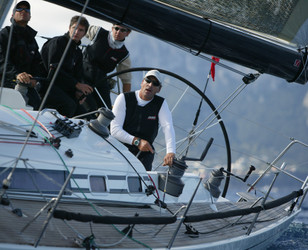One wheel good, two wheels better?
Posted by Dave on Jan 10th 2023
When I first started racing on big boats, the coolest boats all had gigantic wheels, preferably sunk deep into the deck. Getting the helmsperson outboard as far and as comfortably as possible was the goal. On our family's classic C&C 34, good luck seeing the jib telltales or anything else forward of the mast for that matter. Taking the wheel of a then-pretty cutting edge Judel/Vrolijk 48 with a proper mega wheel was a revelation - you could see EVERYTHING! Of course this necessitated a recess well of about a 4' radius semi-circle dug into the deck, all of which made getting aft (especially belowdecks) a bit of an adventure - but boy could you see stuff from the helm. For me, this era climaxed in the late 90s and early 2000s with Farr 40s and IMS (remember them?) boats that went so big with the wheel that an overly aggressive main trimmer could put the boat on autopilot - that last hit of mainsheet tension could put the boom right into the wheel.
Nowadays, the favored way to skin this cat is with two wheels spread as far apart as possible. This leaves the boom about a zip code away from touching the wheels, opens up a freeway in the middle of the cockpit, deletes the need for the deck recess, and still puts the helmsperson in an ideal position. As with everything, there are a few tradeoffs.

One of the first things we do when spec'ing a steering system on a new design is to estimate helm loads. This is an aggregate of a bunch of factors including the general boat specs, rudder balance, quadrant size, gear ratios, etc. The idea is to create a manageable and responsive helm that is comfortable to steer, gives enough feedback, doesn't require a linebacker to turn, and doesn't require two full turns of the wheel just to tack. There's a deep dive we'll take separately into all of that, but the wheel radius is an important part of this calculus. A larger wheel gives more leverage, which mitigates bigger loads at the rudder.
The flipside of this is that smaller wheels give less leverage, so if you normalize between the two for "load in hand" while steering, you need more turns of the wheel per degree of turn (easier gear ratio) on the twin wheel setup. The feel is different, but larger turns of a smaller wheel are easier. You can turn a 30" wheel pretty hard just by moving your hands, where the same degree of wheel movement on a 7' wheel would have you hand-over-hand a few times. The upshot of this is that, even with an easier gear ratio, a twin-wheeled boat with small wheels can be very responsive. High speed apparent wind reaching on a twin-wheeled boat is a piece of cake.
The mechanics of the systems are different, with the twin-wheel boat requiring a more complex setup - two wheels, two chains, etc. Depending on the degree of redundancy you're after, each wheel can steer the boat in complete absence of the other, but most don't go this route. The lack of a carnival wheel in the back makes for easier movement through the cockpit, and it's not hard to find a story about the guy who nearly got his foot chopped off between a wheel spoke and the deck recess.
Both systems can work great.

